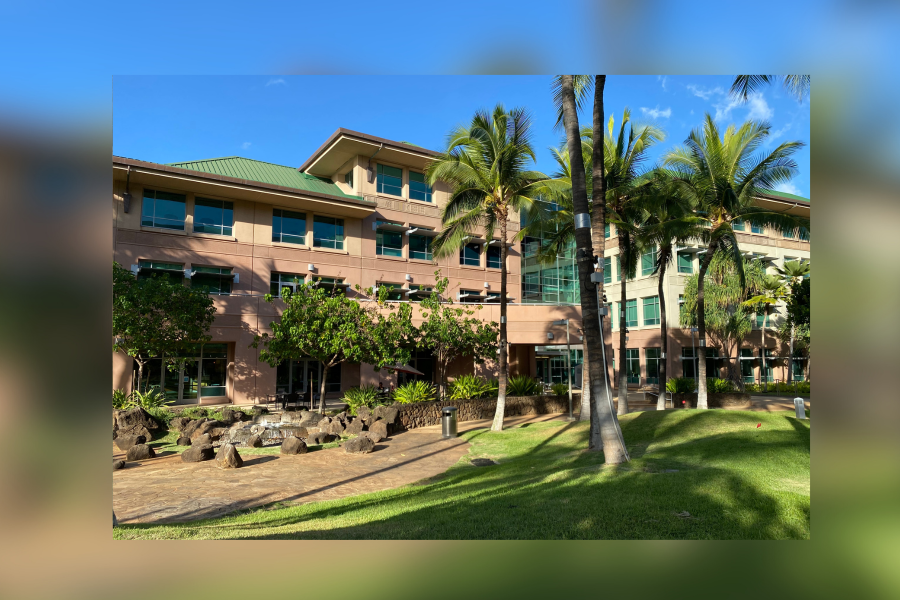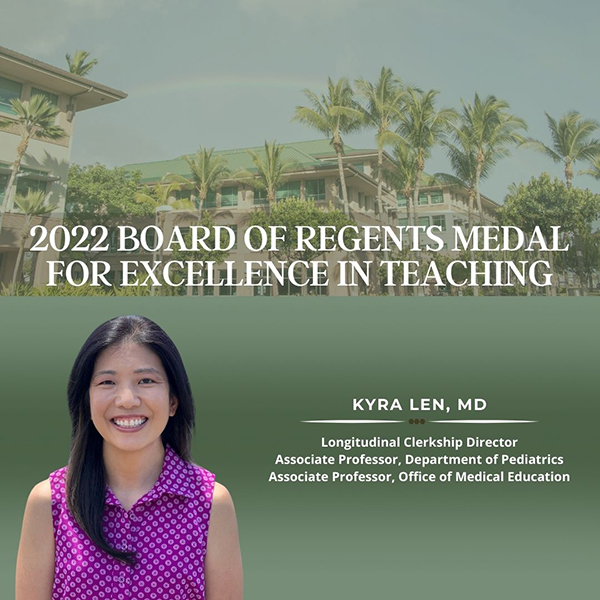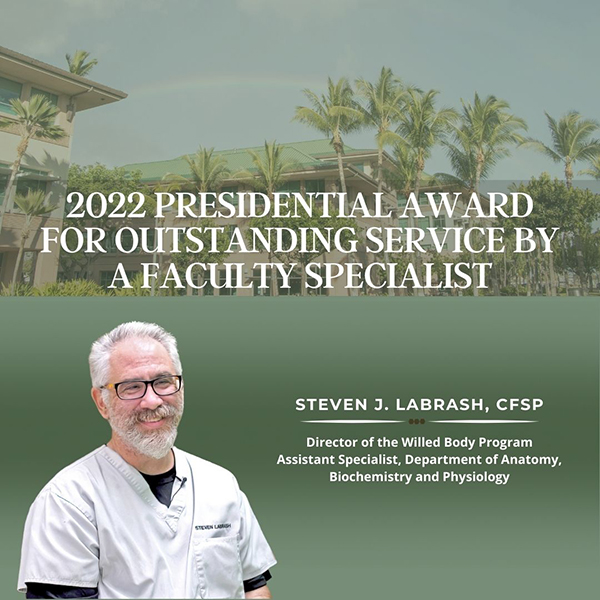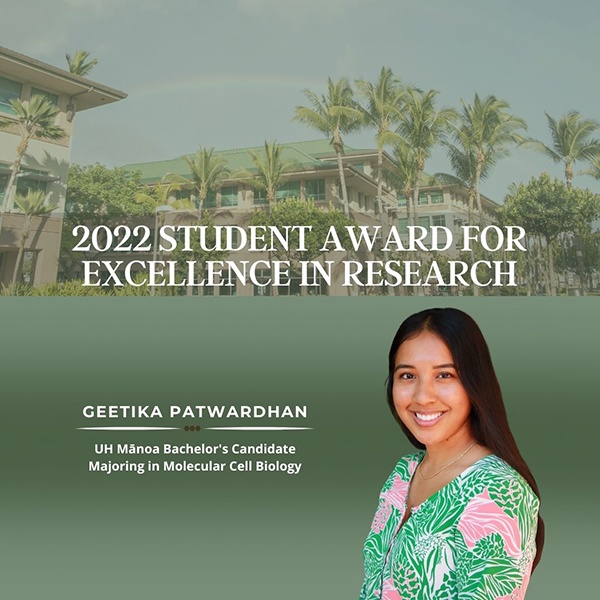
Several faculty members at the John A. Burns School of Medicine (JABSOM) and a student will be recognized at the 2022 University of Hawaiʻi Mānoa (UHM) Awards Ceremony on May 2, 2022 for their outstanding commitment to enhancing the university’s mission of excellence. The ceremony will honor award recipients of 2020, 2021 and 2022 and will also be livestreamed.
JABSOM Dean Jerris Hedges is pleased but not surprised about the large turnout of awardees from the UH medical school. “JABSOM continues to produce excellent, caring physicians and researchers and one of the reasons is our dedicated faculty members who are passionate about teaching,” said Hedges. “Our students are bright and enthusiastic, having come to JABSOM with the intention of training under world-class mentors as they work towards reaching their career goals in science and/or medicine.”
Congratulations to UHM award recipients Drs. Kyra Len, Scott Lozanoff, Jason K. Higa as well as Steven Labrash and Geetika Patwardhan.
For many years, Dr. Kyra Len has been lauded by a range of learners including both medical students and resident physicians for her teaching style. She is interactive and prompts the learner for answers, engaging them in clinical correlation and thinking about the next steps in a patient’s treatment or diagnosis while providing helpful and constructive feedback. Her main philosophy is to think of creative ways to teach so that JABSOM students and residents can best care for their patients and to become lifelong learners.
Dr. Kenneth Nakamura, professor and chair of the Department of Pediatrics, recalls a workshop at a curriculum retreat in 2019 led by Len.
“She had faculty participants close their eyes to imagine their loved ones being cared for by a JABSOM graduate in order to inspire the faculty to work on improving our curriculum to train the best possible physicians,” Nakamura said.
Len has led innovative curriculum initiatives adopted by JABSOM and nationally, which includes converting third-year medical students to a complete longitudinal integrated clerkship as well as launching the new learning communities curriculum, which comprises small groups of students at different stages of medical school, with faculty advisors. The learning communities curriculum earned Len and co-director Dr. Vanessa Wong awards at the 2021 UHM Innovation and Impact Showcase. In addition, she created a “point-of-care” tool for pediatric diagnosis now available on phones and started a “boot-camp” for fourth year students to equip them with skills geared towards their specialties so that they feel confident in beginning residency post-graduation.
Nakamura says Len is an integral member of JABSOM whose work trains compassionate, competent and empathetic physicians and is “highly approachable and creative in her teaching approach.”

Dr. Scott Lozanoff, former chair of the Department of Anatomy, Biochemistry and Physiology, has employed highly creative means in his teaching style and has provided outstanding lectures and labs and contributed a legacy of gross anatomy to JABSOM medical and graduate students.
Over a decade ago, he began to utilize the use of virtual reality and 3-D imaging systems as novel educational materials. He leveraged his knowledge and skill even further when the state’s stay-at-home order was implemented in 2020 during the COVID-19 pandemic, prompting institutions across the country to provide hybrid and distance-learning options. Lozanoff led the department’s initiative of repurposing green screens to enhance the delivery of online dissection and anatomy classes. This innovation earned Lozanoff an award at the 2021 UHM Innovation and Impact Showcase.
In collaboration with Lozanoff’s startup company Rad3D, JABSOM has been able to produce anatomical structures in “augmented reality” and literally make a 3D image of an organ pop off the pages of a book. The software enabled online presentation for MRI scans of JABSOM’s silent teachers, those who selflessly willed their bodies to the medical school and the longevity of its anatomical education. In collaboration with faculty from the departments of medicine and pathology, they developed cases for each of the silent teachers that students could work through and to allow for the medical students to benefit from both online cadaver dissection and recorded, engaging 3D lectures. Other UHM schools including the College of Education’s Kinesiology and Rehabilitation Science and the Academy of Creative Media were also included in this project.
“With Dr. Lozanoff’s leadership, the team was able to establish the novel gross anatomy teaching system we witness today: using hybrid labs with VR/3D models and the sound stage and green screen to provide instruction,” said Dr. Takashi Matsui, chair of the department. “The new system will be retained post-COVID and likely expanded further. I thank Dr. Lozanoff for his tremendous efforts on teaching and invaluable contributions to our medical education.”
Since 2004, Steven Labrash has served as director of the Willed Body Program (WBP), which allows students, physicians and other healthcare professionals to gain valuable information and learn the complexities of the human body through the generous body donations whom JABSOM calls its “silent teachers.” Throughout his leadership, the WBP has exuded utmost dignity and respect to its silent teachers, which comes across to the families and friends of the donors. Every year, the number of donors to the WBP has grown, with 185 silent teachers and nearly 820 families honored at the 2019 WBP Memorial Service.
“Amid the COVID-19 pandemic, Mr. Labrash and his team successfully curated the first online memorial service in April 2020, maintaining the same success ever since. With his help, not even a pandemic could stunt the heartfelt quality to the ceremony,” said Matsui.
Labrash’s top-notch leadership extends past the UH system as he is well-known internationally for his expertise in anatomical teaching materials. He has served as a representative in the West Coast Consortium of Academic Donation Programs since its inception 20 years ago, when Labrash worked at the University of California San Diego. Upon moving to Hawaiʻi, the consortium agreed to include Hawaiʻi in all of its future meetings.
“We thank Mr. Labrash for his impeccable ability to bridge communities and establish notable improvements such as these,” said Matsui. “Both in and out of the classrooms, Mr. Labrash’s leadership in the program is essential to fulfilling the holistic mission of medical education.”

After obtaining his PhD in Cell and Molecular Biology at JABSOM and working for three years as a postdoctoral fellow in Dr. Takashi Matsui’s lab, Jason Higa has since continued to impact UH Mānoa as an assistant professor in the Department of Anatomy, Biochemistry and Physiology.
“Throughout each experience, I have witnessed firsthand the ways in which Jason’s profound mindset sources his authentic passion for teaching,” said Matsui.
Higa’s talent in teaching may be due largely to his versatility and adaptability. He is able to teach students over a wide range of subject difficulty and educational abilities including high school, undergraduate, graduate and medical students. In the Matsui Lab, Higa worked especially well with high school and undergraduate school volunteers and was more than willing to spend the extra time teaching them new basic science skills and explaining concepts to them. At the medical school, Higa easily adapted to teaching the medical students, incorporating advanced techniques in animation to convey difficult concepts. Due to his enthusiasm for education, he quickly became a valued lecturer at JABSOM.
In addition, he teaches and manages hundreds of undergraduate students and eight lab sections with the assistance of four teaching assistants, whom he works closely with in building a foundation of knowledge and skills. Recently, Higa began serving as a preclinical course director organizing the cardiopulmonary curriculum. Currently, he contributes to teaching both undergraduate students (physiology) at UH Mānoa and JABSOM medical students.
“Dr. Higa is an outstanding lecturer who has repeatedly and effectively exhibited a genuine care for the learning and wellbeing of his students,” said Matsui. “I believe he is highly deserving of this award.”

Geetika Patwardhan is an undergraduate and senior honors student at UH Mānoa majoring in Molecular Cell Biology. Since her freshman year, she has been a research assistant in JABSOM’s Department of Anatomy, Biochemistry, and Physiology under the mentorship of Dr. Ben Fogelgren, associate professor.
“One of the most impressive things about Geetika is her drive to learn as much as she can and master every technique and technology. Also, Geetika has always been dedicated to understanding the deeper biological principles and medical context of her research. She has devoted many extra hours to reading scientific articles, attending research seminars, and consulting with faculty, and thus has developed an incredibly advanced perspective on her research,” said Fogelgren. “I am confident that she will become one of our future leaders in biomedical science and medicine.”
Patwardhan’s research is focused on identifying new molecular mechanisms in neurons that regulate the production of amyloid-beta, a peptide that accumulates as plaques in the brains of Alzheimer’s disease patients. She has won a number of national awards for her research, including the Barry Goldwater Research Scholarship and a professional development award from the Society for Neuroscience. After graduation, she will continue her training at the National Institutes of Health’s main campus in Bethesda, Maryland under the two-year Intramural Research Training Award program.
The Mililani native hopes to one day play a key role in translating research advances to improvements in patient care as a physician-scientist in Hawaiʻi.